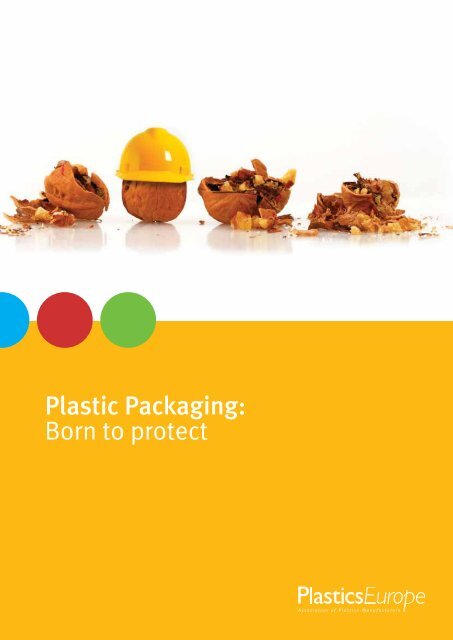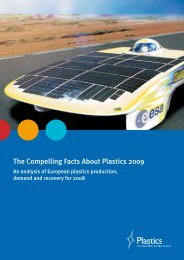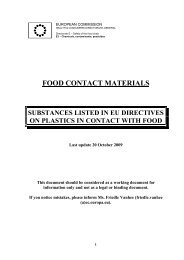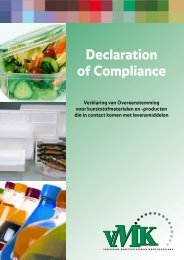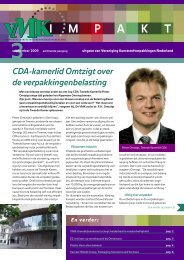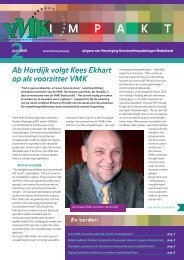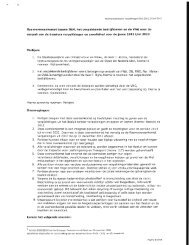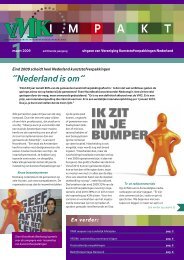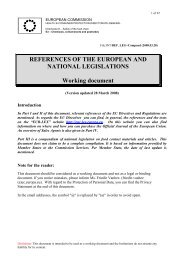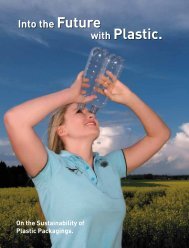Plastic Packaging: Born to protect - Wir tragen Verantwortung
Plastic Packaging: Born to protect - Wir tragen Verantwortung
Plastic Packaging: Born to protect - Wir tragen Verantwortung
You also want an ePaper? Increase the reach of your titles
YUMPU automatically turns print PDFs into web optimized ePapers that Google loves.
<strong>Plastic</strong> <strong>Packaging</strong>:<br />
<strong>Born</strong> <strong>to</strong> <strong>protect</strong>
Contents<br />
Keeping food fresher, for longer<br />
Saving resources and energy<br />
Convenience at your fingertips<br />
Reuse <strong>to</strong> reduce<br />
Bioplastics: the beginning of a new era?<br />
3
<strong>Plastic</strong><br />
packaging:<br />
is essential for processing,<br />
s<strong>to</strong>ring, transporting,<br />
<strong>protect</strong>ing and preserving<br />
products.<br />
Nice <strong>to</strong> have<br />
or must have?<br />
<strong>Plastic</strong> packaging represents<br />
almost 39% of the plastics<br />
market and as such is now<br />
an important, integral part<br />
of our daily lives. Therefore<br />
it is critical that <strong>to</strong>day’s<br />
consumers understand<br />
that packaging is not only<br />
practical but equally an<br />
indispensable <strong>protect</strong>ion for<br />
products as it:<br />
is not harmful <strong>to</strong><br />
the environment if<br />
properly disposed of.<br />
means more with less:<br />
less waste, less energy,<br />
less resources used,<br />
reduced cost and lower<br />
GHG emissions across<br />
its full life-cycle.<br />
Source: <strong>Plastic</strong>s the facts 2011<br />
5
Keeping food fresher,<br />
for longer<br />
“In developing countries, 40% of food losses occur at post-harvest<br />
and processing levels. This is partly due <strong>to</strong> the lack of appropriate<br />
packaging solutions”. Source: FAO report “Global Food Losses and Food Waste”<br />
6
Less food waste from production <strong>to</strong> shelves<br />
In its 2011 report, the FAO stressed that one of the reasons behind food losses and waste in developing countries is<br />
the lack of appropriate packaging solutions. In Europe, only 3% of all products delivered <strong>to</strong> cus<strong>to</strong>mers are spoilt during<br />
transport thanks <strong>to</strong> packaging, compared <strong>to</strong> 50% in developing countries.<br />
Extended shelf life<br />
From pre-baked bread rolls, packed under nitrogen, <strong>to</strong> meat <strong>protect</strong>ed by oxygen barrier plastic films, food is kept fresher<br />
for longer thanks <strong>to</strong> plastic packaging. The more plastic packaging used, the more food saved.<br />
Selling grapes in trays<br />
or bags has reduced<br />
in-s<strong>to</strong>re waste of grapes<br />
by 20%.<br />
The shelf-life of beef<br />
can be extended by five<br />
<strong>to</strong> ten days, or even<br />
longer, when using the<br />
most advanced plastic<br />
packaging solutions.<br />
Only 1.5 grams of<br />
wrapping plastic can<br />
keep a cucumber fresh<br />
for 14 days.<br />
Solid <strong>protect</strong>ion<br />
inspired by nature<br />
Just like a nut is <strong>protect</strong>ed by a shell, plastic packaging<br />
provides unequalled physical <strong>protect</strong>ion for foodstuff.<br />
For instance, egg breakage is reduced by 80% when using<br />
plastic egg packs instead of alternative materials 1 .<br />
A glimpse of the future<br />
<strong>Plastic</strong> packaging can already triple shelf life thanks <strong>to</strong> its<br />
unique properties that allow for resealable portioned films<br />
and packs, anti-microbial agents, humidity control systems<br />
and modified atmosphere packaging solutions.<br />
In the near future, new innovations will become<br />
available such as printable RFID tags (Radio-frequency<br />
identification) that provide warnings over temperature<br />
changes and humidity levels that might affect the<br />
integrity of the product. Absorbers and emitters of natural<br />
occurring gaseous substances will prolong the s<strong>to</strong>rage of<br />
food. Even further in<strong>to</strong> the future, biosensors that detect<br />
bacteria and viruses will pave the way <strong>to</strong> safeguard the<br />
quality and safety of food for consumers whilst further<br />
reducing food waste.<br />
7<br />
1 Source: Denkstatt study on the impact of plastic packaging on energy consumption and GHG emissions
Saving resources<br />
and energy<br />
“Responsible for only 0.6% of the European consumer’s average carbon<br />
footprint, plastic packaging preserves far more resources than it uses”.<br />
8
Energy use and GHG emissions of products<br />
Producing one kilo of beef leads <strong>to</strong> emissions equivalent <strong>to</strong> three hours of car driving and requires 15,500 litres of<br />
water, which is equivalent <strong>to</strong> the water consumption of a person having 100 baths. Thanks <strong>to</strong> the prevented food<br />
loss, using a few grams of plastics packaging means saving at least 13 times the emissions from producing the<br />
packaging itself!<br />
1.5 L PET bottle 0.085 kg CO 2<br />
0.5 L PP meat tray 0.084 kg CO 2<br />
Energy use and emissions of products<br />
0.5 L PP yoghurt pot 0.073 kg CO 2<br />
0.5 L PS tray 0.065 kg CO 2<br />
1 m2 LDPE film 12µ 0.049 kg CO 2<br />
1 kg beef 13.3 kg CO 2<br />
1 kg coffee 8.5 kg CO 2<br />
1 kg french fries 5.7 kg CO 2<br />
1 kg soft cheese 1.95 kg CO 2<br />
79% cheese<br />
manufacture<br />
2% cheese packaging<br />
3% transport packaging<br />
3% transport from the fac<strong>to</strong>ry<br />
3% retail<br />
2% shopping trip<br />
8% s<strong>to</strong>rage in the fridge<br />
1 kg pasta 0.22 kg CO 2<br />
Source: IK” and title “CO2 emissions of packaging VS products”<br />
Source: Incpen<br />
The smallest environmental footprint<br />
Only 1.5% of all oil and gas consumed in Europe is used as a raw material <strong>to</strong> produce plastic pakaging whereas 90%<br />
of it is used for heating, transportation and energy generation. If food was packed using other materials than plastics,<br />
the related energy consumption would double and greenhouse gas emissions would nearly triple. This would also be<br />
accompanied by a 360% increase in the weight the packaging!<br />
Consumer carbon footprint in Europe<br />
24% Other consumption products<br />
18% Heating (Private homes)<br />
15% Food<br />
14% Cars<br />
11% Public services<br />
8% Aviation<br />
7% Electricity (Private homes)<br />
1.7% <strong>Packaging</strong><br />
1% Public transport<br />
Source: Denskstatt study on the impact of plastic packaging on energy consumption and GHG emissions<br />
9
Light as a feather<br />
The plastics industry is committed <strong>to</strong> constantly reducing the amount of plastics used in its products without<br />
compromising on strength and durability. Ten years ago, the average plastic packaging weight was 28 % higher<br />
than <strong>to</strong>day and even more for some applications.<br />
Reduction in weight of a 1 litre detergent<br />
bottle over the last 40 years<br />
120<br />
Bottle Weight (g)<br />
100<br />
80<br />
60<br />
40<br />
64% reduction<br />
20<br />
0<br />
1970’s 1990’s 2000 2008<br />
Source: Incpen<br />
Controlled growth<br />
Whilst overall society consumption levels rose by 20% between 1999 and 2004, the use of plastics packaging only<br />
rose by 4% . This means that plastics help reduce the impact of a burgeoning consumption.<br />
What if plastics packaging was replaced by alternative materials?<br />
Total masses<br />
for same functional units<br />
66 million<br />
t/a<br />
Energy consumption<br />
in <strong>to</strong>tal life-cycle<br />
2250 million<br />
GJ/a<br />
GHG emissions<br />
in <strong>to</strong>tal life-cycle<br />
97.4 million<br />
t/a<br />
x3.6<br />
18.4 million<br />
t/a<br />
<strong>Plastic</strong>s<br />
Alternative materials<br />
x2.2<br />
1010 million<br />
GJ/a<br />
<strong>Plastic</strong>s<br />
Alternative materials<br />
x2.7<br />
36.6 million<br />
t/a<br />
<strong>Plastic</strong>s<br />
Alternative materials<br />
10<br />
Figure 1: Effect of substitution of selected plastic packaging on masses, energy demand & GHG emissions<br />
Source: Denskstatt study on the impact of plastic packaging on energy consumption and GHG emissions
Convenience<br />
at your fingertips<br />
“<strong>Plastic</strong>s’ success s<strong>to</strong>ry in the packaging market isn’t just a lucky<br />
break. Not only do they provide consumers with the best value for<br />
money, but they are lighter, more resistant, more flexible, safer, more<br />
hygienic, and more innovative than any other material”.<br />
12
Versatility<br />
<strong>Plastic</strong>s are highly versatile. They can be used in a<br />
broad range of applications including food, electronics,<br />
cosmetics and health care. They can be cus<strong>to</strong>mised <strong>to</strong><br />
accommodate specific characteristics and requirements<br />
of products even after being recycled. Did you know<br />
that fleece jackets can be made of plastic bottles?<br />
Transparency<br />
When buying a product, consumers like <strong>to</strong> see<br />
its appearance and <strong>to</strong> be sure it matches their<br />
expectations. <strong>Plastic</strong> packaging provides this<br />
transparency and helps reduce bruising and other<br />
potential damage caused when handling products such<br />
as strawberries.<br />
Hygiene and safety<br />
Consumers expect packaging <strong>to</strong> <strong>protect</strong> products from<br />
damage and <strong>to</strong> preserve its integrity . This is what<br />
plastics do best: they <strong>protect</strong> against contamination<br />
of food and medicine as well as a barrier against<br />
microbes, physical damage, humidity and UV radiation.<br />
They also prolong food shelf and guarantee the sterility<br />
of medicines and medical devices.<br />
Ease of use<br />
<strong>Plastic</strong> packaging guarantees ease of use for everyone<br />
from children <strong>to</strong> elderly and plays a vital role in daily<br />
life. It provides consumers with clear identification<br />
and labelling. It is easy <strong>to</strong> open, use and seal. A plastic<br />
bottle, for instance, is unbreakable, which makes it<br />
safe and handy for hiking, children’s packed lunches,<br />
etc.<br />
13
Reuse <strong>to</strong><br />
reduce<br />
“<strong>Plastic</strong> packaging conserves its value even beyond its end-of-life. It<br />
can be recycled in<strong>to</strong> new products or recovered as energy <strong>to</strong> reduce<br />
the consumption of virgin fossil fuels and <strong>protect</strong> the environment”.<br />
14
The sustainable choice<br />
The net benefits of recycling and recovering plastic<br />
packaging are often higher than that of alternative<br />
materials. Even in the case of rigid packaging such as<br />
cups and bottles, which may lead <strong>to</strong> substantial GHG<br />
emissions and energy consumption during production, this<br />
is more than compensated by its suitability for recycling.<br />
Environmental performance of <strong>Plastic</strong><br />
packaging VS alternative materials<br />
GHG emissions<br />
Alternative<br />
packaging materials<br />
Energy consumption<br />
Alternative<br />
packaging materials<br />
Outstanding performance<br />
In 2010 European recycling levels for plastic packaging<br />
reached almost 33% thereby reducing plastic packaging<br />
life-cycle energy demand by 24% and GHG emissions by<br />
27%. This is just a glimpse of what can be achieved, as<br />
recycling rates are growing by an average 2% each year.<br />
5.0 M<strong>to</strong>nne<br />
2.5 M<strong>to</strong>nne<br />
0.0 M<strong>to</strong>nne<br />
<strong>Plastic</strong>s Waste Recycling in EU27<br />
2006<br />
4.0<br />
2007<br />
5.0<br />
2008<br />
5.2<br />
2009<br />
5.5<br />
2010<br />
6.0<br />
Year<br />
Source: <strong>Plastic</strong>s the facts 2011<br />
<strong>Plastic</strong> packaging<br />
at current recycling levels<br />
100000<br />
80000<br />
60000<br />
40000<br />
20000<br />
kt CO 2 equiv/a<br />
0<br />
500<br />
1000<br />
<strong>Plastic</strong> packaging<br />
at current recycling levels<br />
Mill GJ/a<br />
Source: Denskstatt study on the impact of plastic packaging on energy consumption<br />
and GHG emissions<br />
A tremendous success<br />
1500<br />
2000<br />
2500<br />
3000<br />
As innovations improve the economics of sorting and<br />
cleaning processes, the quality of plastic packaging<br />
recyclates is continuously improving. This leads <strong>to</strong> a<br />
growing confidence among brand owners that recyclates<br />
are a versatile and valuable raw material option for many<br />
of their products.<br />
Making the most of raw<br />
materials<br />
Although all plastics are recyclable, this process<br />
needs <strong>to</strong> ultimately result in saving energy and/or raw<br />
materials. Multilayer packaging films, for instance,<br />
preserve food for longer but are not economically and<br />
environmentally viable <strong>to</strong> recycle. In such a scenario,<br />
recovering plastics’ embedded energy <strong>to</strong> create heat,<br />
electricity or even road fuel, thereby displacing virgin<br />
fossil fuels, is <strong>to</strong>day the best option for our planet.<br />
Thanks <strong>to</strong> current research, this non-recyclable plastic<br />
could however be depolymerized and converted back<br />
in<strong>to</strong> virgin polymer in the very near future.<br />
According <strong>to</strong> the<br />
German federal<br />
environmental agency,<br />
new plastic carrier<br />
bags often contain<br />
up <strong>to</strong> 80% recycled<br />
material<br />
In the UK, plastic milk bottles currently contain up <strong>to</strong> 10% of<br />
recycled materials, and this share is expected <strong>to</strong> rise up <strong>to</strong> one<br />
third in the near future.<br />
Used plastics are also<br />
a very cost-effective<br />
and efficient way of<br />
providing heat and<br />
electrical power in<br />
cities around Europe<br />
15
Bioplastics<br />
the beginning of a new era?<br />
“Bioplastics are the newest members of the plastics family and,<br />
as such, certainly hold the promise of exciting possibilities”.<br />
16
Biodegradable plastics:<br />
micro-organisms come<br />
in<strong>to</strong> play!<br />
Made of fossil or biofuel, biodegradable/<br />
compostable plastics can be degraded by<br />
biological processes during composting.<br />
At their end of life if directed <strong>to</strong> specific industrial<br />
composting environments, they will dissolve and<br />
decompose back in<strong>to</strong> natural elements.<br />
Bio-based <strong>Plastic</strong>s:<br />
a raw material alternative<br />
Corn, sugar cane or starch can be used <strong>to</strong><br />
produce packaging with the same characteristics<br />
as fossil fuel-based plastics. They account<br />
for nearly 1% of the market, allow for further<br />
diversification in raw materials and are already<br />
used in healthcare and hygiene products,<br />
food and beverage packaging, cutlery, <strong>to</strong>ys,<br />
bags, pipes, au<strong>to</strong>motive applications and even<br />
consumer electronics.<br />
What’s next?<br />
Promising research and development currently<br />
under way in Europe might soon allow for the<br />
production of plastics from CO 2<br />
emissions.<br />
17
2012-04<br />
20<br />
<strong>Plastic</strong>sEurope AISBL<br />
Avenue E. Van Nieuwenhuyse 4/3<br />
B - 1160 Brussels Belgium<br />
Telephone: +32 (0) 2 675 3297<br />
Fax: +32 (0) 2 675 3935<br />
info@plasticseurope.org<br />
www.plasticseurope.org


